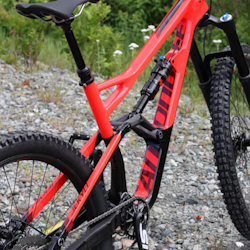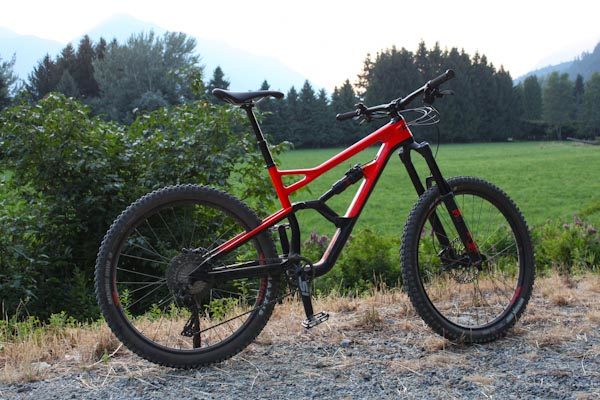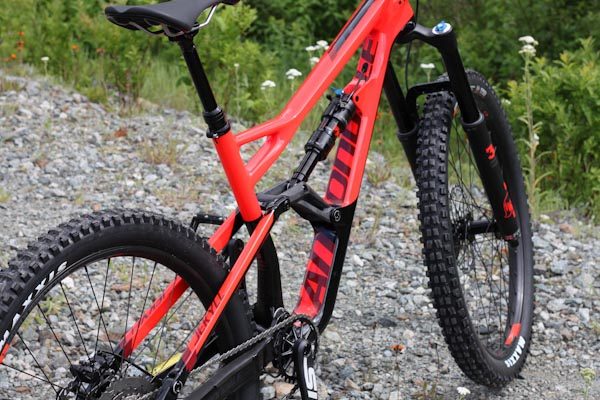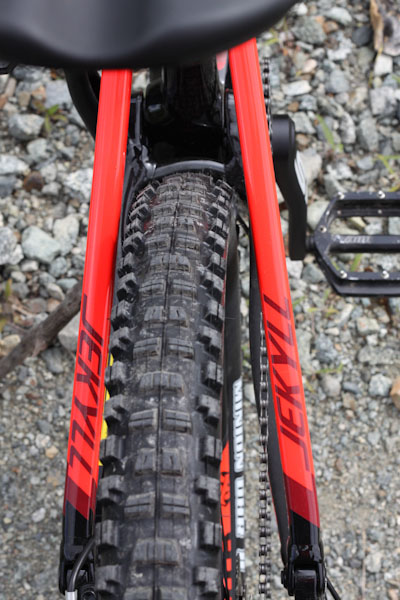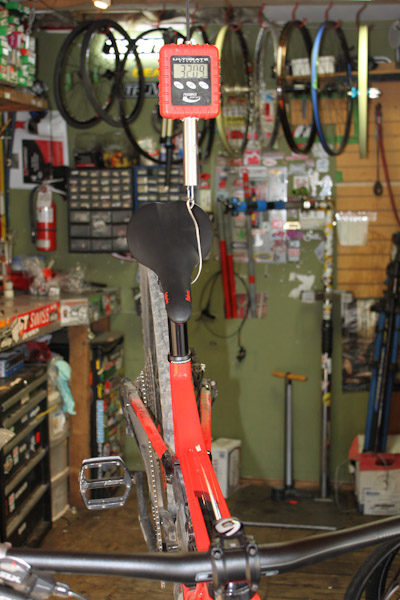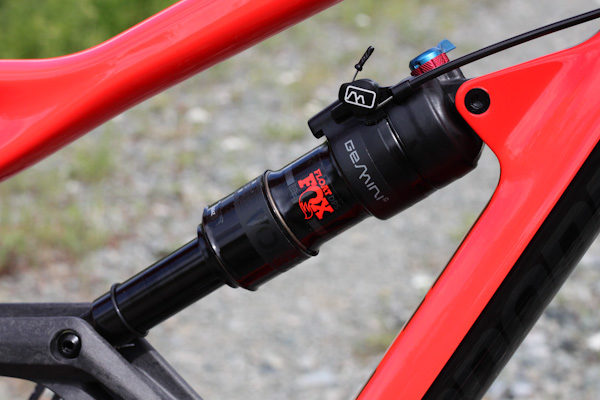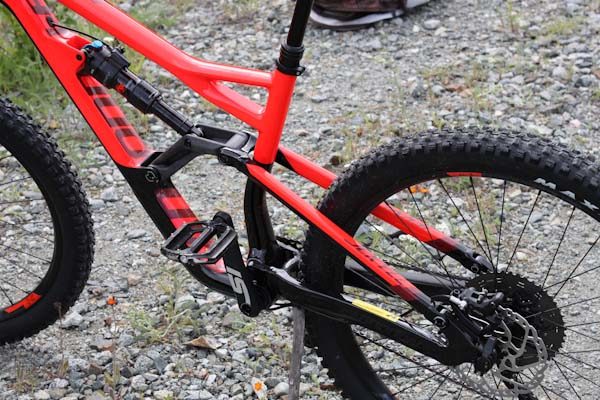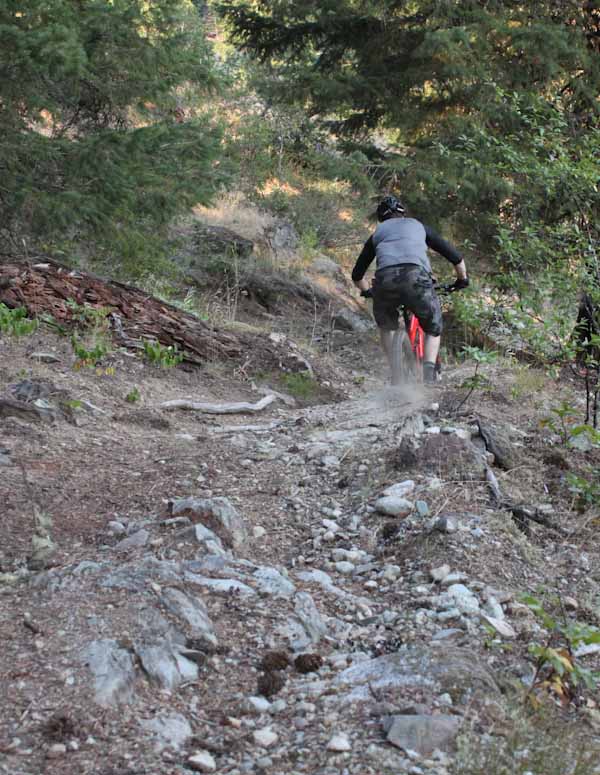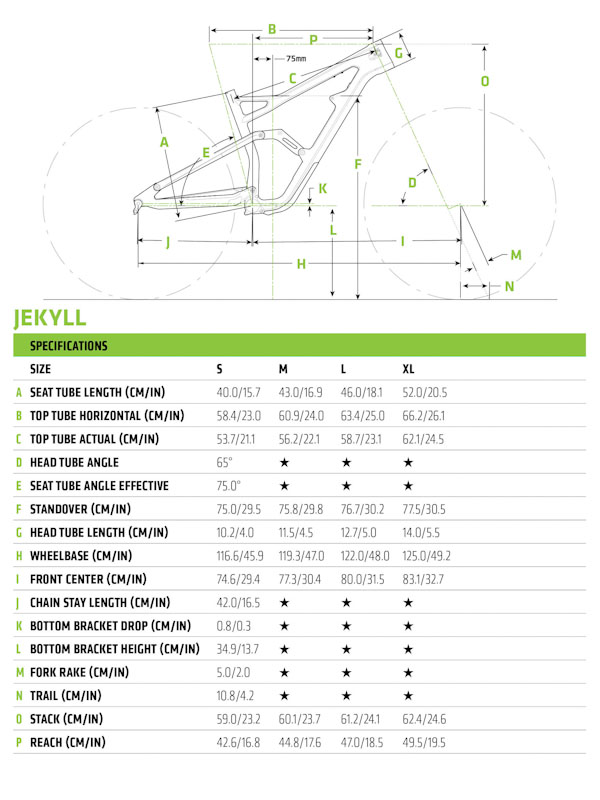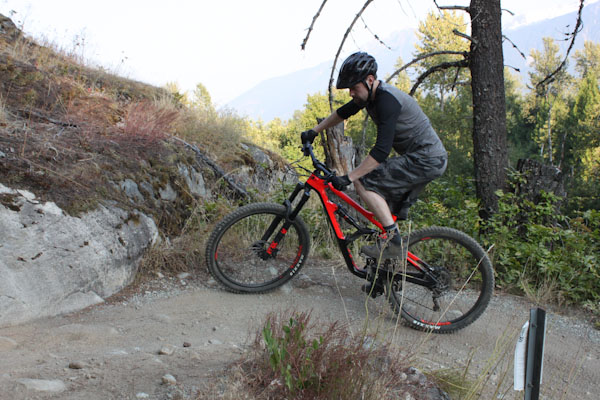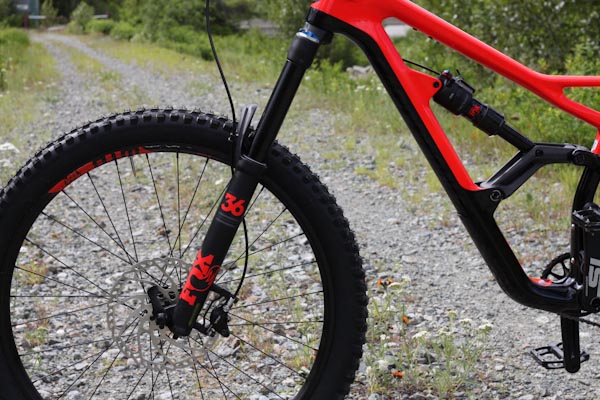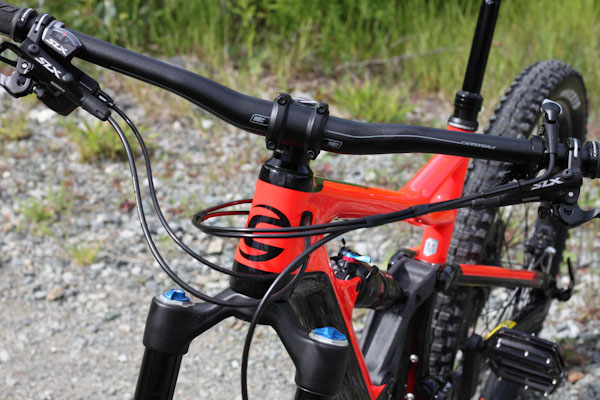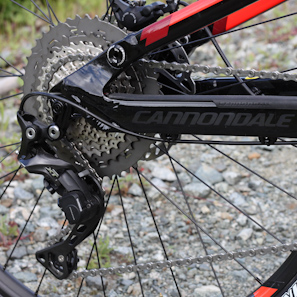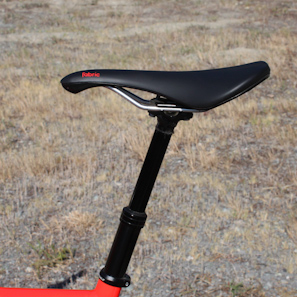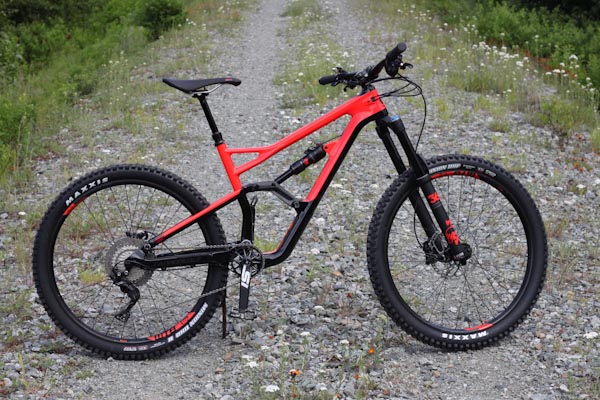As the name suggests, the Cannondale Jekyll has two distinct personalities. Most of that is the result of the Gemini-equipped Fox rear shock which adjusts its travel from 130-165mm and changes its spring rate with the press of a button. In climb mode the bike’s rear end rides high, leaning you into a solid position for efficient pedalling. When descending the open shock sags deeper and allows you to hang back while it gobbles up steep, rough terrain.
I tested the Jekyll 3, which is the lower-mid level model but still gives you everything an enduro bike should – it offers plenty of travel on both ends, it’s long, slack and stiff, and component-wise it’s fully equipped for enduro racing…
First off, this thing is one unique lookin’ bike. On my first few rides I was excitedly asked ‘What is THAT?’ by lots of wide-eyed locals. I like the bold color scheme and racey graphics, and it seems others do too. The Jekyll features a BallisTEC carbon front end with an aluminum rear triangle that looks very leggy, but the chainstays are actually a pretty stout 420mm. The two halves are joined by a carbon rocker link.
I didn’t put the bike on a scale until my testing was nearly over, and I was quite surprised how hefty the Jekyll actually was at 32.09 lbs (with pedals). On the trail I always thought the bike felt far lighter than that, but I guess it’s not a contender in the flyweight class – at least at this build level.
The most significant feature of the Jekyll is the Gemini rear shock, which offers two modes Cannondale calls Hustle and Flow. Hustle mode is for gettin’ on up, and with the press of a handlebar-mounted button the rear shock is limited to 130mm of travel and the spring rate becomes stiffer. Flow mode opens the shock’s full 165mm of travel with a more linear progression for plowing down rough trails with ease.
The Fox Float Performance DPS EVOL shock’s open, medium, and firm modes offer a discernibly different feel with each click. The Firm setting is very firm, so it transfers pedal power well but I wouldn’t recommend it for climbing anything too bumpy. Medium allows the shock to use its travel more, and provides a softer ride on technical singletrack. I didn’t notice any huge loss of pedalling efficiency in this setting, so it quickly became my choice for going up.
The Open mode lets you get deep into the shock’s stroke, and gives a pretty linear feel until the bitter end. The ride immediately feels more lively in open mode, but the plushness becomes really obvious when the rear wheel takes a big hit.
As you may or may not expect, the Jekyll is a pretty efficient pedaling machine. I was a bit worried that the bike would be reliant on its stiffening/shortening trickery, but it wasn’t a terrible climber when I left the rear shock wide open at full travel. Using the Gemini switch definitely helps with your body position though, so you’ll want to take advantage of it.
While climbing, you can tell the shock is in short/stiff mode when square-edged rocks come along, however the rear end remains active enough to keep your tire planted. Traction while climbing in the saddle was excellent; I rode in some very dusty conditions and can’t remember spinning a wheel at all. Standing up I did manage to loosen the back tire, but only on a few steep bursts.
With 165mm of travel in the rear (and a 170mm fork), I had high hopes for the Jekyll’s descending capabilities and the bike did not disappoint. The rear end feels quite active and hungry to absorb bumps, and Cannondale’s claim of ‘You won’t know jack’ seemed to hold true. The bike did a great job of smoothing out one particular tooth-chattering section of my local trails, and with the shock wide open its ability to take bigger hits really shines through.
Despite being supple under impact, the linkage still gives enough support to pedal uphill bursts fairly well and help boost you forward while pumping through flowy trails. As you’d expect from its beefy carbon front triangle, the frame proved to be nice and stiff. While pinballing through rocks and roots, the Jekyll never needed much convincing to hold a straight line.
The Jekyll’s front triangle is definitely lengthy; I’m not sure how much longer a medium frame should be! But that said, I quickly came to really appreciate the geometry of this bike. With its steep 75° effective seat tube angle, the Jekyll puts you in a great position for pushing the pedals despite its long reach.
I was very impressed with how centered I felt over the bike while descending. It was like my body was perfectly balanced between the wheels, and this made the ride feel really stable and grippy. After not long I found myself pushing into corners harder than I usually do, which put a big smile on my face.
The most interesting thing about the Jekyll’s geometry is how the Gemini switch affects it – by limiting the rear travel the Hustle mode keeps your back end riding high, making it easy to keep your weight forwards while climbing. When you switch into Flow mode, you don’t notice a huge difference in your riding position until you put the rear shock to work – on the descents, it becomes obvious how much more active the shock is and you get that ‘slack and laid back’ feeling as you dive deeper in the travel.
As for components, Fox’s 170mm Float 36 Performance fork was stiff and smooth as a magic carpet. My only issue with the fork is that I (weighing 145 lbs) find the medium and firm settings a bit too firm to use on the trails. Even with my air pressure on the low side and the only volume spacer removed I’m just getting full travel, and given that you can’t lower the fork for climbing I’m hesitant to sacrifice any sag by firming it up.
Cannondale’s C3 780mm bar and 35mm stem made for excellent steering, feeling snappy in the corners but stable on the straights. The SLX brakes and 203/180mm rotors provided plenty of braking power, but they were pretty grabby so modulation could be better.
The 11-speed Shimano rear cassette offers a huge range but looks cobbled together, and takes some large leaps into its lowest few cogs. The gaps between the lowest three gears were noticeable, so I would have been happier with an even spread. On the upside, the XT derailleur and SLX shifter performed perfectly.
Fabric’s Radius Scoop saddle agreed with me, and the Trans-X 120mm dropper post worked without fault. The Maxxis Minion 2.4 and 2.5” DHF/DHR II tires and 29mm WTB Frequency Race rims made for a very grippy combo, even in the dusty conditions I had during testing.
All in all I really enjoyed my time aboard the Jekyll. The adjustable suspension setup provides solid pedalling performance or eager bump absorption as needed, and the way the Gemini system affects the geometry really helps make the bike an effective dual-duty machine. While it’s not the lightest option out there, Cannondale has kept up-to-date with all the appointments you’d want on a modern enduro racer, and again, the Jekyll is one sharp looking bike!
The Jekyll 3 retails for $4199 USD. For more information, check out Cannondale’s website.
